Are you a Quiet Speculation member?
If not, now is a perfect time to join up! Our powerful tools, breaking-news analysis, and exclusive Discord channel will make sure you stay up to date and ahead of the curve.
I’ve been thinking a lot about why I haven’t been excited about investing in Theros cards. A couple weeks ago, Anthony Capece published a great piece over on BrainstormBrewery.com regarding rares from large sets. If you haven’t read it, you really should, because he has some great insight that led to some really compelling points.
As a Magic player who interprets all things from the perspective of Draft, I would add to his points that the yearly Draft format has a lot to do with large-set prices. Consider this: we’re currently drafting three packs of Theros. When Born of the Gods comes out, we’ll still be drafting two packs of Theros and only one of the new set. Finally, Journey into Nyx will come out, and even in the late spring drafters will be cracking packs of Theros. A full 66% of drafted cards this block are going to be Theros, with only 22% and 11% being Born of the Gods and Journey into Nyx, respectively.
That means there’s going to be six times more Theros drafted than Journey, and three times more than Born. Any speculation as to what percentage of cards enter the market via Draft would just be a guess, but I feel confident in saying it’s a substantial amount. The frequency of seeing any given rare differs between a large set and a small set, sure. This is certainly a contributing factor to card prices, but the fact remains that there are going to be a lot more Theros cards in circulation than cards from the other sets in the block.
Examining Innistrad with the Aid of Hindsight
With Innistrad rotated, now is a good time to look at what the rares in the set did during its time in Standard. The block format for Innistrad was large-small-large, meaning that only 55% of drafted cards that year were from the fall set, but if anything, this should mean Innistrad cards were, during the set’s time in Standard, in slightly lower supply than Theros cards will be at the conclusion of the year (ignoring sales numbers, since we don’t have that information available).
Examination of Innistrad shows that there wasn’t a lot of money to be made speculating on rares, except maybe right around the set’s release. Don’t believe me? Take a look at the below list. I think it’s safe to say all of these cards were Standard staples, or at least staple-ish.
Champion of the Parish: After hitting $5 right around the time of its release, this card stayed in the $4 to $6 range for basically its entire time in Standard. Any deck that played it wanted four copies, and it saw plenty of play in several white weenie variants, most popularly in The Aristocrats. Many saw it as a good spec after Return to Ravnica was released, but it never saw a significant spike.
Gavony Township: Here’s a card that saw lots of Standard play, still sees Modern play, and has plenty of casual appeal. I never really heard of people speculating on it, which is probably good, because the price only shifted about 80 cents one way or another from $2.
Kessig Wolf Run: There was an entire archetype named after this card. It’s hard to be more of a staple than that. It wasn’t a four-of, but it was played an awful lot. However, unless you bought in at the prerelease and sold right away, you likely didn’t make any money here. The card didn’t fluctuate more than a dollar either way after settling to a normalized price.
Moorland Haunt: Here’s another card that saw consistent play all year long. It wasn’t ever a four-of, but it has seen some singleton play in Modern. And yet there was never an opportunity to make money speculating here—the card steadily declined throughout its Standard life.
Nephalia Drownyard: This one was a four-of at points, and it actually did triple up between Gatecrash and Dragon’s Maze. However, it tripled up from $0.50 to $1.50, meaning that after shipping and fees, there was not much profit here, unless you went deep at the perfect time and outed en masse.
Runechanter's Pike: I know that I bought a couple playsets of this card at $0.49 after Delver won its first big tournament, and sure, I traded them out at $2 each. Profit is profit, I guess, but it certainly wasn’t much. Despite this card being the win condition in a few iterations of similar decks during its time, it never broke past that $2 mark. Why? Obviously there are many factors, but a big one is that it’s a fall-set rare.
Finding Opportunity Despite All This
The above graphs sure make it seem like a bad idea to speculate on Standard rares from fall sets. Are there exceptions? Sure! With Innistrad and Scars of Mirrodin, it certainly paid off to pile away the rare dual lands. But with devotion running rampant in Standard, shock lands haven’t spiked like the buddy and fast lands. If a mono-color theme is supported in next year’s block, we may see temples perform more like shock lands than the rare duals of the prior two years. As someone who has a pretty deep position in shock lands (and just generally likes speculating on real estate), I’m hoping the dual-colored gods encourage mana bases with more rare duals. But given the current situation in Standard, it’s hard to advocate moving in on temples. They’re powerful, but they are tap lands.
You know where there was opportunity to make small profits on Innistrad rares? Bulk rares that started seeing play. I didn’t go deep or anything, but I did purchase a few playsets of the following three cards at around bulk prices, $0.15 - 0.25 each:
The first two, Blasphemous Act and Sever the Bloodline, I threw in some random TCG Player carts whenever I saw prices at bulk level. This was pretty common while Innistrad was still being drafted. These are both obviously powerful cards that didn’t have a home, but when they found one, they both spiked to about $3. At $0.15 each, that represents a 2000% gain, which is a pretty big number, even though in real life it’s just a couple bucks per card.
Cackling Counterpart was a fairly common spec based on the populate mechanic. We never got the creature that made the infinite combo here, but just based on casual demand (and probably people speculating the same as me), I was able to buylist out all my copies for at least two to three times what I spent. Turning dimes into quarters isn’t great, but if things had gone differently it could have been dimes into dollars, and that would have been sweet.
Buying in on powerful bulk rares didn’t make me a ton of money, but it did make me some, and put me at very close to zero risk. My advice to you is to wait a couple more months for Theros rares to bottom out, then comb TCG Player for ones at bulk prices. We’re not bottomed out yet, but I’m keeping a close eye on Chained to the Rocks, Fabled Hero, and Prognostic Sphinx.
What you shouldn’t do is speculate on Theros rares that are above bulk but not seeing a lot of play. The godly weapons (e.g. Whip of Erebos) come to mind. These are already sitting at $1 - 3 each, and I think that if they were going to spike, they would have already spiked. At best, they’ll fluctuate within a dollar or two, but I don’t anticipate any triple-ups or better. When all is said and done, don’t be surprised to see graphs that look similar to the Innistrad spell lands discussed above.
The Big Ones
I haven’t mentioned Innistrad’s flagship rare, Snapcaster Mage. This is a rare that outpriced many mythics during its Standard tenure, always maintained a high price, and still hasn’t dropped even post-rotation. On the contrary, it will probably slowly grow forever, at least until it’s reprinted. There are a lot of factors contributing to this price history, but it mostly stems from the card’s eternal playability.
Does Theros have a comparable card? Thoughtseize, of course, has some real pedigree. It’s a Legacy, Modern, and Standard staple, and is possibly even more played than Snapcaster Mage. And yet, check this out:
Maybe I’m seeing things, but that looks like a steady decline since the reprint. How much lower can it go? I’m not really sure, but I am sure that people are going to be cracking these in Draft for the next six months. There will come a time to buy in, probably, since a card with this pedigree can’t just fall in price forever, but I think it’s pretty clear that selling is the right call for now. I’ve certainly been selling all of the copies I’ve been drafting.
And Now to Proceed with Caution
Doing this analysis, I’ve learned that after the hype has worn off of fall-set rares, they are not the place to spec if I’m looking for crazy spikes. In fact, it seems like most of them don’t really grow at all after finding a stable price—some consistently-played staples even steadily decline. The big exception in recent years has been rare dual lands, and a little low-risk money can be made speculating on cards at bulk prices, as well. But when I’m looking for potential triple-ups or better, from now on I’ll be looking at small sets, mythics, and eternal cards.


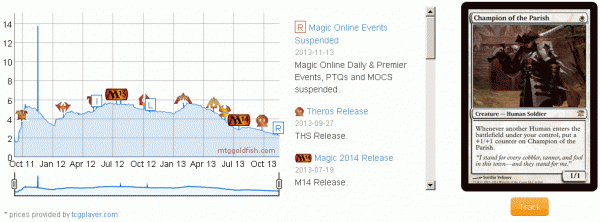
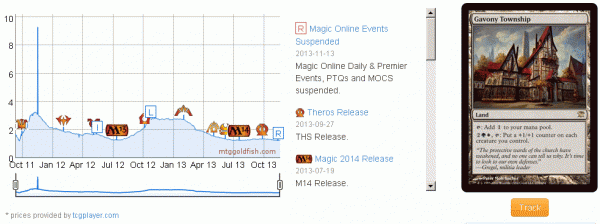
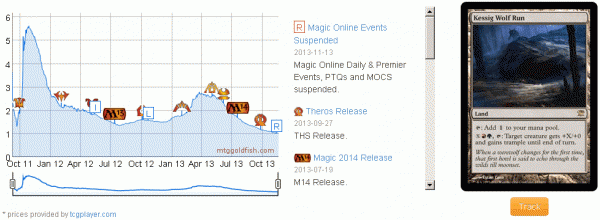
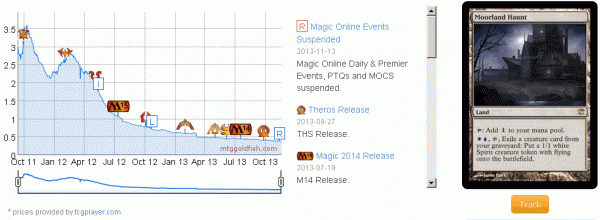
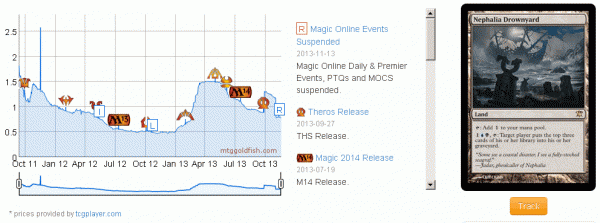
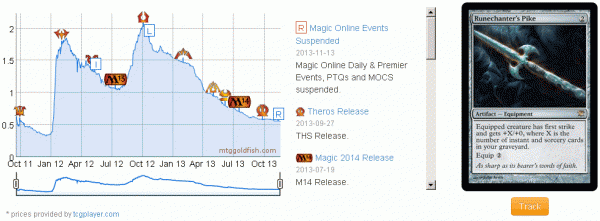
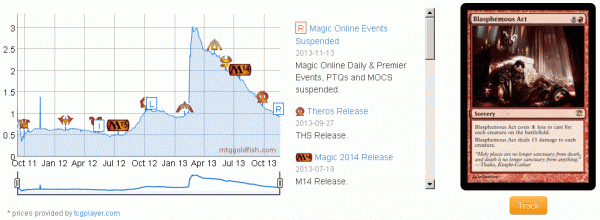
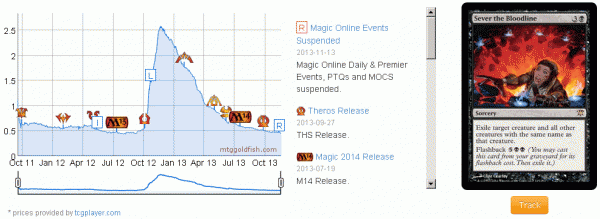
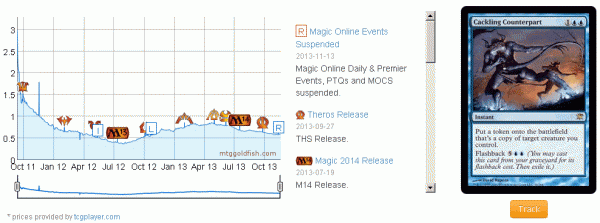
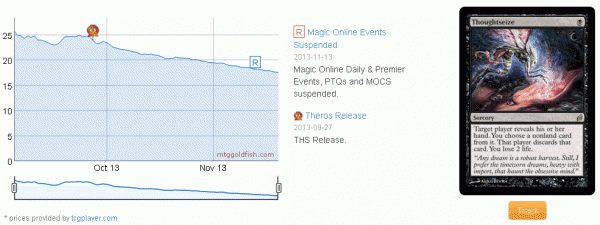



This is a profoundly important question. The same could be said of all of the cards in Dragon\’s Maze but one or two of them. Sometimes the answer is no and this will help us evaluate future sets. I mean, maybe. It\’s hard to see it coming.
maybe the only 1st block set that was good in invest in was zendikar?
im banking on thoughtseize hitting lows of 10. currently approaching 14 even though everybody said buy at 15 was good:
http://bidwicket.com/Item/C/Collectible_Card_Games/Magic_the_Gathering/Singles/Theros/97488_Thoughtseize.html
Thoughtseize is the one card I’m willing to buy enough for all my decks (~24 copies). I got in a bit high at $17, but I feel fine about it. If price lowers further (due to people opening packs) I’ll definitely invest in it.
I never got why Nephalia Drownyard didn’t really go up. It was more played than Desecration Demon today! Is it just the coolness factor, people prefering to win with AEtherling punchs than a land that grinds you out? Maybe many FNM control players opted for Psychic Spiral, or the Jace, Memory Adept, or what have you. Win with nothing but a land? So lame. Whereas the Demon, although ineffective in an aggro or a control build, gets inserted in every deck because he’s a pretty cool guy. Comes down turn four, the opponent cries “he’s so unfair!”, you have always “won” regardless of whether he gets killed a turn later. He is an awesome card.
RE: Nephalia Drownyard
Maybe it was because it could pretty much only fit in one deck? I don’t know, it surprised me as well.
All I know for sure was that it was miserable to play against after they stabilized.
Did you forget about the innistrad dual lands?
No, I mentioned them explicitly.
Wow. Great analysis, epic graphs, and an extremely well written article. Nicely done Sir.
This was an excellent article.